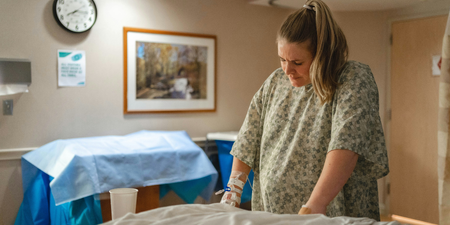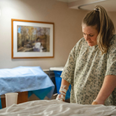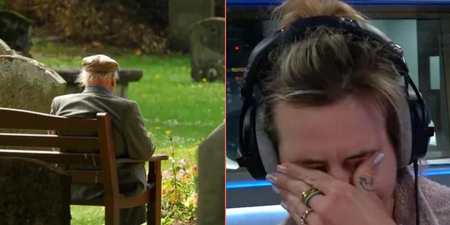“There is silence, and so many people don’t understand how damaging that is.”
Nicola Henegan could write a book on all of the therapies she’s tried to tackle her endometriosis.
Acupuncture, meditation, homeopathy, osteopathy, clean eating, energy healing, and abdominal therapy to name but a few.
Diagnosed with the often misunderstood condition after years of severe and sudden bouts of pain, Nicola is one of countless women in Ireland who had their symptoms mismanaged, their pain discredited, and their experience disregarded.
Endometriosis, thought to affect 10 percent of women in Ireland, involves tissue similar to that inside of the uterus growing outside of the womb, usually in the fallopian tubes or ovaries.
In Nicola’s case, the tissue was growing in her bowel, causing excruciating and debilitating pain that often left her doubled over in agony, and sometimes passing out.
“I would never know when it was going to happen,” she tell Her. “It’s a graphic way of describing it but it was like trying to pass a bowling ball. I never knew when it was going to strike.
“There’s the cramps that come with getting your period but this was a particularly bad pain. Once my husband found me upstairs collapsed on the floor, covered in sweat. My kids were seeing me like that, I couldn’t go on living that way.”

So, Nicola decided to do some research. Her symptoms did not match up with traditional endometriosis cases, leaving her convinced that she didn’t have the condition at all.
She was experiencing something else, she had to be. Her doctors had told her so.
Nicola’s uncertainty didn’t stop her from doing everything she could to receive a correct diagnosis. She cleaned up her diet, she spoke to other women, she discovered the Endometriosis Association of Ireland and attended their annual conference in search of answers.
There, she spoke to a specialist doctor who offered to take a look at an MRI she had gotten previously. Her results had initially come back clear, but this time the report was different.
Nicola decided to travel to a specialised London clinic in January of this year for a scan of her bowel. It was during this visit that she saw first hand the damage endometriosis was causing to her body.
“I could see them as clear as day on the screen, the nodules in my bowel, causing all of this horrific pain,” she says. “It was such a relief to see them and to have someone listen to me. I knew I wasn’t going crazy.
“A lot of women have this problem, our concerns are dismissed. Even after the surgery I wasn’t convinced that I did have endometriosis. It’s ingrained into our subconscious that our periods are meant to be painful and that we should just get over it.
“I’ve looked at pictures of what your insides are supposed to look like, and it was pretty obvious that something was going on in there for a long time. It was everywhere.”
https://www.instagram.com/p/B-UEN9iFe6c/
Nicola travelled to London again this summer for the procedure to remove the nodules in her bowel. A lack of specialised doctors in Ireland means that endometriosis treatment often requires the patient to travel abroad.
That’s after waiting an average of nine years to receive a correct diagnosis, if you ever get one at all.
Nicola says that the issue around endometriosis isn’t just the in-availability of treatment, but the lack of understanding of the condition in the first place.
“In Ireland there’s still a shame around periods,” she says. “I’m a pharmacist and the amount of women I’ve chatted to who haven’t got a clue how their cycle works. Education is so important.
“Of all of the controversy that the Tampax ad caused, the majority of people who complained were women. It’s disgraceful and it’s something that we need to tackle in schools, young girls need to be more aware of their cycles.”
Nicola recommends Lisa Hendrickson-Jack’s The Fifth Vital Sign as a starting point for better educating ourselves about our cycles.
The textbook details how the menstrual cycle acts as an indicator of a woman’s health, just like her blood pressure or temperature, telling us when we’re healthy and, more importantly, when something is wrong.
“If we learned about this in school, we would be equipped with adequate and essential information on these conditions,” says Nicola. “Especially endometriosis, because sometimes life changing decisions can be made because of misinformation.
“There is silence, and so many people don’t understand how damaging that is. Silence is a disease, we need to speak up and not be ashamed.
“The average waiting time for an endometriosis diagnosis is nine years. That’s a glaring example of how women’s pain is dismissed.”
You can learn more about endometriosis here or find out more about the Endometriosis Association of Ireland here.




















































